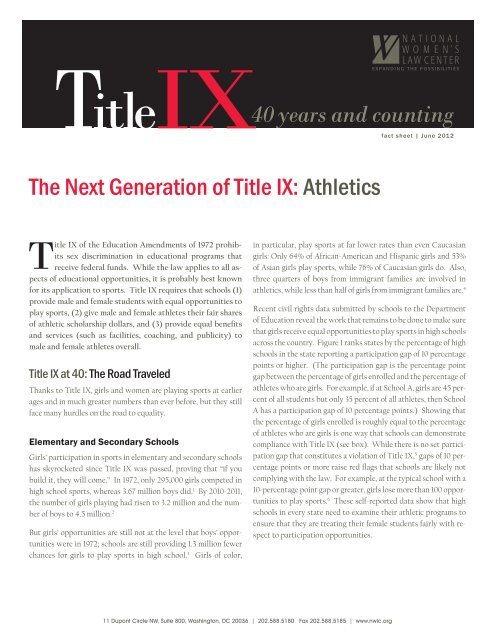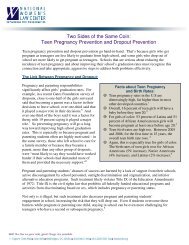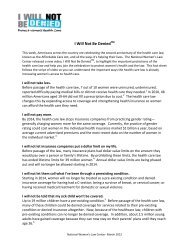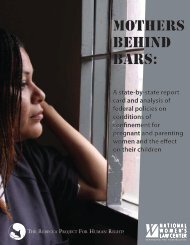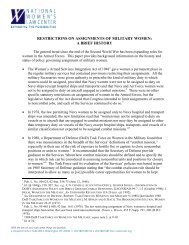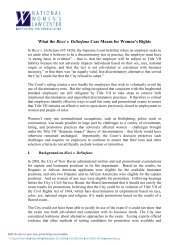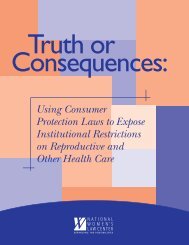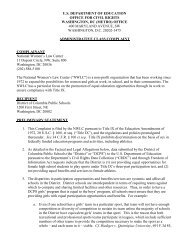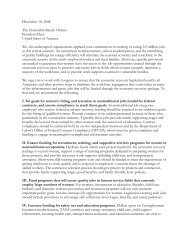The Next Generation of Title IX: Athletics 40 years and counting
The Next Generation of Title IX: Athletics 40 years and counting
The Next Generation of Title IX: Athletics 40 years and counting
Create successful ePaper yourself
Turn your PDF publications into a flip-book with our unique Google optimized e-Paper software.
TITLE <strong>IX</strong>: ATHLETICS • FACT SHEET<br />
<strong>Title</strong><strong>IX</strong> fact<br />
<strong>The</strong> <strong>Next</strong> <strong>Generation</strong> <strong>of</strong> <strong>Title</strong> <strong>IX</strong>: <strong>Athletics</strong><br />
<strong>Title</strong> <strong>IX</strong> <strong>of</strong> the Education Amendments <strong>of</strong> 1972 prohibits<br />
sex discrimination in educational programs that<br />
receive federal funds. While the law applies to all aspects<br />
<strong>of</strong> educational opportunities, it is probably best known<br />
for its application to sports. <strong>Title</strong> <strong>IX</strong> requires that schools (1)<br />
provide male <strong>and</strong> female students with equal opportunities to<br />
play sports, (2) give male <strong>and</strong> female athletes their fair shares<br />
<strong>of</strong> athletic scholarship dollars, <strong>and</strong> (3) provide equal benefits<br />
<strong>and</strong> services (such as facilities, coaching, <strong>and</strong> publicity) to<br />
male <strong>and</strong> female athletes overall.<br />
<strong>Title</strong> <strong>IX</strong> at <strong>40</strong>: <strong>The</strong> Road Traveled<br />
Thanks to <strong>Title</strong> <strong>IX</strong>, girls <strong>and</strong> women are playing sports at earlier<br />
ages <strong>and</strong> in much greater numbers than ever before, but they still<br />
face many hurdles on the road to equality.<br />
Elementary <strong>and</strong> Secondary Schools<br />
Girls’ participation in sports in elementary <strong>and</strong> secondary schools<br />
has skyrocketed since <strong>Title</strong> <strong>IX</strong> was passed, proving that “if you<br />
build it, they will come.” In 1972, only 295,000 girls competed in<br />
high school sports, whereas 3.67 million boys did. 1 By 2010-2011,<br />
the number <strong>of</strong> girls playing had risen to 3.2 million <strong>and</strong> the number<br />
<strong>of</strong> boys to 4.5 million. 2<br />
But girls’ opportunities are still not at the level that boys’ opportunities<br />
were in 1972; schools are still providing 1.3 million fewer<br />
chances for girls to play sports in high school. 3 Girls <strong>of</strong> color,<br />
<strong>40</strong> <strong>years</strong> <strong>and</strong> <strong>counting</strong><br />
in particular, play sports at far lower rates than even Caucasian<br />
girls: Only 64% <strong>of</strong> African-American <strong>and</strong> Hispanic girls <strong>and</strong> 53%<br />
<strong>of</strong> Asian girls play sports, while 76% <strong>of</strong> Caucasian girls do. Also,<br />
three quarters <strong>of</strong> boys from immigrant families are involved in<br />
athletics, while less than half <strong>of</strong> girls from immigrant families are. 4<br />
Recent civil rights data submitted by schools to the Department<br />
<strong>of</strong> Education reveal the work that remains to be done to make sure<br />
that girls receive equal opportunities to play sports in high schools<br />
across the country. Figure 1 ranks states by the percentage <strong>of</strong> high<br />
schools in the state reporting a participation gap <strong>of</strong> 10 percentage<br />
points or higher. (<strong>The</strong> participation gap is the percentage point<br />
gap between the percentage <strong>of</strong> girls enrolled <strong>and</strong> the percentage <strong>of</strong><br />
athletes who are girls. For example, if at School A, girls are 45 percent<br />
<strong>of</strong> all students but only 35 percent <strong>of</strong> all athletes, then School<br />
A has a participation gap <strong>of</strong> 10 percentage points.) Showing that<br />
the percentage <strong>of</strong> girls enrolled is roughly equal to the percentage<br />
<strong>of</strong> athletes who are girls is one way that schools can demonstrate<br />
compliance with <strong>Title</strong> <strong>IX</strong> (see box). While there is no set participation<br />
gap that constitutes a violation <strong>of</strong> <strong>Title</strong> <strong>IX</strong>, 5 gaps <strong>of</strong> 10 percentage<br />
points or more raise red flags that schools are likely not<br />
complying with the law. For example, at the typical school with a<br />
10-percentage point gap or greater, girls lose more than 100 opportunities<br />
to play sports. 6 <strong>The</strong>se self-reported data show that high<br />
schools in every state need to examine their athletic programs to<br />
ensure that they are treating their female students fairly with respect<br />
to participation opportunities.<br />
11 Dupont Circle NW, Suite 800, Washington, DC 20036 | 202.588.5180 Fax 202.588.5185 | www.nwlc.org<br />
sheet | June 2012
Figure 1<br />
Rank State<br />
1 New Hampshire 2.0%<br />
2 Hawaii 4.8%<br />
3 Maine 7.5%<br />
4 Minnesota 10.7%<br />
5 Vermont 11.4%<br />
6 Montana 13.6%<br />
7 North Dakota 14.5%<br />
8 Washington 15.4%<br />
9 South Dakota 15.7%<br />
10 Colorado 16.1%<br />
11 Massachusetts 17.3%<br />
12 Connecticut 17.5%<br />
13 Wyoming 17.6%<br />
14 Rhode Isl<strong>and</strong> 19.4%<br />
15 Wisconsin 19.6%<br />
16 Alaska 20.2%<br />
17 Pennsylvania 20.2%<br />
18 Kentucky 22.7%<br />
19 New Jersey 22.8%<br />
20 Michigan 23.9%<br />
21 New York 24.7%<br />
22 Maryl<strong>and</strong> 25.3%<br />
23 Oregon 25.5%<br />
24 West Virginia 26.9%<br />
25 Kansas 27.2%<br />
26 Utah 27.2%<br />
27 Nebraska 27.5%<br />
28 Virginia 27.7%<br />
29 Delaware 29.0%<br />
30 Florida 29.3%<br />
31 New Mexico 29.6%<br />
32 Illinois 31.4%<br />
33 Iowa 31.5%<br />
34 Indiana 32.0%<br />
35 California 33.5%<br />
36 Missouri 34.5%<br />
37 Idaho 35.4%<br />
38 Ohio 36.1%<br />
39 Nevada 39.5%<br />
<strong>40</strong> Oklahoma 39.8%<br />
41 Arizona 41.2%<br />
42 Arkansas 49.6%<br />
43 Mississippi 53.9%<br />
44 North Carolina 54.9%<br />
45 Dist. <strong>of</strong> Columbia 57.1%<br />
46 Texas 59.4%<br />
47 South Carolina 61.4%<br />
48 Alabama 62.2%<br />
49 Louisiana 62.2%<br />
50 Tennessee 65.4%<br />
51 Georgia 71.6%<br />
Source: NWLC’s calculations are based on U.S. Department <strong>of</strong> Education, Civil Rights<br />
Data Collection (CRDC), flat file. CRDC data are for school year 2009-2010 <strong>and</strong> cover<br />
about 85 percent <strong>of</strong> the nation’s public school students. <strong>The</strong>se data are not intended to<br />
be estimates <strong>of</strong> state or national data. All data in the CRDC are self-reported. Schools<br />
are included in NWLC’s calculations if they have a 10th grade <strong>and</strong> reported athletes.<br />
Single-sex schools are excluded from NWLC’s calculations.<br />
TITLE <strong>IX</strong>: ATHLETICS • FACT SHEET<br />
Percentage <strong>of</strong> high schools<br />
in the state reporting a<br />
participation gap <strong>of</strong> 10<br />
percentage points or higher<br />
Colleges <strong>and</strong> Universities<br />
Women’s participation in intercollegiate athletics has also increased<br />
greatly since 1972, when fewer than 32,000 women<br />
played sports, 8 women received only 2% <strong>of</strong> schools’ athletics<br />
budgets, <strong>and</strong> athletic scholarships for women were nonexistent. 9<br />
Today, a record 193,232 women compete, over six times the pre-<br />
<strong>Title</strong> <strong>IX</strong> rate. 10<br />
But the playing field is still not level. While more than half <strong>of</strong> the<br />
students at NCAA schools are women, they receive only 44% <strong>of</strong><br />
the athletic participation opportunities. 11 Moreover, female athletes<br />
at the typical Division I-FBS (formerly Division I-A) school<br />
receive roughly 28% <strong>of</strong> the total money spent on athletics, 31%<br />
<strong>of</strong> the recruiting dollars, <strong>and</strong> 42% <strong>of</strong> the athletic scholarship<br />
dollars. 12 In addition, at the typical FBS school, for every dollar<br />
spent on women’s sports, about two <strong>and</strong> a half dollars are spent<br />
on men’s sports. 13<br />
Under <strong>Title</strong> <strong>IX</strong>, there are three<br />
independent ways for schools to demonstrate<br />
that they are providing their male <strong>and</strong> female<br />
students with equal opportunities to play sports.<br />
A school must show any one <strong>of</strong> the following:<br />
(1) the percentages <strong>of</strong> male <strong>and</strong> female<br />
athletes are about the same as the<br />
percentages <strong>of</strong> male <strong>and</strong> female<br />
students enrolled, or<br />
(2) the school has a history <strong>and</strong><br />
continuing practice <strong>of</strong> exp<strong>and</strong>ing<br />
athletic opportunities for the<br />
underrepresented sex (almost<br />
always female students), or<br />
(3) the school is fully <strong>and</strong> effectively<br />
meeting its female students’ interests<br />
<strong>and</strong> abilities to participate in sports. 7<br />
11 Dupont Circle NW, Suite 800, Washington, DC 20036 | 202.588.5180 Fax 202.588.5185 | www.nwlc.org
Why It Matters:<br />
<strong>The</strong> Impact on Women <strong>and</strong> Girls<br />
By not providing girls <strong>and</strong> women with equal opportunities to<br />
play sports, schools are denying them the health, academic, <strong>and</strong><br />
economic benefits that accompany participation. Playing sports<br />
decreases a young woman’s chances <strong>of</strong> developing heart disease,<br />
osteoporosis <strong>and</strong> breast cancer. 14 Research shows that girls who<br />
had opportunities to play sports because <strong>of</strong> <strong>Title</strong> <strong>IX</strong> had a 7 percent<br />
lower risk <strong>of</strong> obesity 20 to 25 <strong>years</strong> later when they were in<br />
their late 30s <strong>and</strong> early <strong>40</strong>s. 15 <strong>The</strong> study notes that while a 7 percent<br />
decline in obesity is modest, “no other public health program<br />
can claim similar success.” 16 Female athletes have higher levels <strong>of</strong><br />
self-esteem, a lower incidence <strong>of</strong> depression, <strong>and</strong> a more positive<br />
body image compared to non-athletes. 17 Female student-athletes<br />
are also less likely to smoke or use drugs 18 <strong>and</strong> have lower rates <strong>of</strong><br />
both sexual activity <strong>and</strong> pregnancy 19 than non-athletes.<br />
Sports participation also has a positive effect on academic<br />
achievement. Young women who play sports are more likely to<br />
graduate from high school, have higher grades, <strong>and</strong> score higher<br />
on st<strong>and</strong>ardized tests than non-athletes. 20 <strong>The</strong>y are also more<br />
likely to do well in science classes than their classmates who do<br />
not play sports. 21 In addition, the availability <strong>of</strong> athletic scholarships<br />
significantly increases young women’s ability to pursue<br />
higher education.<br />
Ensuring equal opportunities in sports is especially important for<br />
girls <strong>of</strong> color. Studies show that they are less physically active<br />
during adolescence than white girls <strong>and</strong> that they are less likely to<br />
participate in sports outside <strong>of</strong> school than white girls. 22 Moreover,<br />
girls <strong>of</strong> color drop out <strong>of</strong> school at alarming rates. While<br />
24% <strong>of</strong> girls overall fail to graduate on time with a diploma each<br />
year, the numbers for girls <strong>of</strong> color are much worse: 44% <strong>of</strong> Native<br />
American female students, 35% <strong>of</strong> Black female students, <strong>and</strong> 34%<br />
<strong>of</strong> Hispanic female students fail to graduate on time. 23<br />
In addition to helping students stay engaged in school, playing<br />
sports has a positive effect on employment outcomes <strong>and</strong> women’s<br />
economic security. A study using state-level data concluded<br />
that an increase in female sports participation leads to an increase<br />
in women’s labor force participation down the road <strong>and</strong> greater<br />
female participation in previously male-dominated occupations,<br />
particularly high-skill, high-wage ones. 24 Research also shows<br />
that more than four out <strong>of</strong> five executive businesswomen played<br />
sports growing up, <strong>and</strong> the vast majority say that the lessons they<br />
learned on the playing field contributed to their success in business.<br />
25<br />
TITLE <strong>IX</strong>: ATHLETICS • FACT SHEET<br />
<strong>Title</strong><strong>IX</strong><br />
<strong>The</strong> Road Ahead:<br />
Recommendations<br />
for Action<br />
<strong>The</strong> U.S. Department <strong>of</strong> Education’s<br />
Office for Civil Rights (OCR) should<br />
strengthen enforcement <strong>of</strong> <strong>Title</strong> <strong>IX</strong><br />
by initiating more compliance reviews<br />
<strong>of</strong> schools <strong>and</strong> negotiating robust<br />
resolutions <strong>of</strong> complaints.<br />
OCR should issue further guidance<br />
to schools about what they can count<br />
as participation opportunities under<br />
<strong>Title</strong> <strong>IX</strong>.<br />
Federal policymakers should require<br />
secondary schools to publicly disclose gender<br />
equity data about their sports programs so<br />
that communities are aware <strong>of</strong> how their<br />
schools are treating boys <strong>and</strong> girls in<br />
athletics.<br />
11 Dupont Circle NW, Suite 800, Washington, DC 20036 | 202.588.5180 Fax 202.588.5185 | www.nwlc.org
<strong>Next</strong> <strong>Generation</strong> Issues<br />
What Counts as a Participation Opportunity<br />
for <strong>Title</strong> <strong>IX</strong> Purposes?<br />
Schools are adding competitive cheer <strong>and</strong> flag football for girls in<br />
attempts to demonstrate that they are providing equal opportunities<br />
for girls to play sports. 26 Yet these activities do not provide<br />
female students with the same types <strong>of</strong> competitive opportunities<br />
that male students receive <strong>and</strong> therefore raise <strong>Title</strong> <strong>IX</strong> concerns.<br />
Competitive cheer, which is evolving, currently does not provide<br />
the same level <strong>of</strong> competition or championship opportunities as<br />
TITLE <strong>IX</strong>: ATHLETICS • FACT SHEET<br />
other varsity sports. <strong>The</strong>refore it should not be counted by schools<br />
in their <strong>Title</strong> <strong>IX</strong> athletic participation numbers. 27 And while flag<br />
football is an exciting sport <strong>and</strong> may be easy to add for girls where<br />
a school already has football for boys, the lack <strong>of</strong> opportunities<br />
to play at the college level <strong>and</strong> earn athletic scholarships in flag<br />
football pose <strong>Title</strong> <strong>IX</strong> concerns where schools provide boys with<br />
varsity sports that all provide such opportunities. Questions also<br />
have arisen over whether schools can count indoor track, outdoor<br />
track, <strong>and</strong> cross-country as separate participation opportunities<br />
<strong>and</strong> under what circumstances. 28<br />
1 NATIONAL FEDERATION OF STATE HIGH SCHOOL ASSOCIATIONS, 2010-11 HIGH SCHOOL ATHLETICS PARTICIPATION SURVEY 52 (2011), available at http://www.nfhs.org/content.<br />
aspx?id=3282.<br />
2 Id.<br />
3 Id.<br />
4 DON SABO & PHIL VELIZ, WOMEN’S SPORTS FOUNDATION, GO OUT AND PLAY: YOUTH SPORTS IN AMERICA 14-15, 161 (Oct. 2008), available at http://www.womenssportsfoundation.org/sitecore/content/home/research/articles-<strong>and</strong>-reports/mental-<strong>and</strong>-physical-health/go-out-<strong>and</strong>-play.aspx.<br />
5 See U.S. Dep’t <strong>of</strong> Educ., Office for Civil Rights, Clarification <strong>of</strong> Intercollegiate <strong>Athletics</strong> Policy Guidance: <strong>The</strong> Three-Part Test (Jan. 16, 1996) at 4-5 [hereinafter 1996 Clarification]<br />
(describing case-by-case approach used to determine whether participation opportunities are “substantially proportionate to enrollment rates,” which depends on the size <strong>of</strong> an<br />
institution’s athletic program <strong>and</strong> whether number <strong>of</strong> opportunities that would be required to achieve proportionality would be sufficient to sustain a viable team).<br />
6 <strong>The</strong> number <strong>of</strong> opportunities lost represents the additional number <strong>of</strong> girls who would be able to play sports if the school closed the participation gap. Typical (median) enrollment at<br />
a school with a ten percentage point gap or greater is 1130 students.<br />
7 See 1996 Clarification. <strong>Title</strong> <strong>IX</strong> also requires the equivalent treatment <strong>of</strong> male <strong>and</strong> female athletes <strong>and</strong> the allocation <strong>of</strong> scholarship dollars among male <strong>and</strong> female athletes proportional<br />
to their representation. See generally U.S Dep’t <strong>of</strong> Health, Educ. <strong>and</strong> Welfare, Office for Civil Rights, A Policy Interpretation: <strong>Title</strong> <strong>IX</strong> <strong>and</strong> Intercollegiate <strong>Athletics</strong>, 44 Fed. Reg.<br />
71,413, 71,418 (Dec. 11, 1979).<br />
8 See U.S. Department <strong>of</strong> Health, Education, <strong>and</strong> Welfare, Policy Interpretation, 44 Fed. Reg. at 71419 (1979).<br />
9 Remarks <strong>of</strong> Senator Stevens (R-AL), 130 Cong. Rec. S4601 (daily ed. April 12, 1984).<br />
10 National Collegiate Athletic Association (NCAA), 1981-82—2010-11 NCAA Sports Sponsorship <strong>and</strong> Participation Rates Report 69-70 (October 2011).<br />
11 Id.<br />
12 National Collegiate Athletic Association, 2004-10 Gender-Equity Report 28-36 (January 2012).<br />
13 Id. at 36.<br />
14 See generally Ellen J. Staurowsky et al., Her Life Depends On It II (Women’s Sports Foundation, East Meadow, N.Y.), Dec. 2009, available at http://www.womenssportsfoundation.<br />
org/home/research/articles-<strong>and</strong>-reports/mental-<strong>and</strong>-physical-health/~/media/PDFs/WSF%20Research%20Reports/Her_Life_II_Full.ashx; Dorothy Teegarden, et al., Previous Physical<br />
Activity Relates to Bone Mineral Measures in Young Women, 28 MEDICINE SCIENCE SPORTS EXERCISE 105 (Jan. 1996); Leslie Bernstein et al., Physical Exercise <strong>and</strong> Reduced<br />
Risk <strong>of</strong> Breast Cancer in Young Women, 86 J. NAT’L CANCER INST. 1<strong>40</strong>3 (1994); see also Marilie D. Gammon et al., Does Physical Activity Reduce the Risk <strong>of</strong> Breast Cancer?, 3<br />
MENOPAUSE: J. N. AM. MENOPAUSE SOC’Y 172, Abstract (1996), available at http://journals.lww.com/menopausejournal/Abstract/1996/03030/Does_Physical_Activity_Reduce_<br />
the_Risk_<strong>of</strong>_Breast.9.aspx.<br />
15 Tara Parker-Pope, As Girls Become Women, Sports Pay Dividends, N.Y. TIMES, Feb. 16, 2010, at D5, available at http://www.nytimes.com/2010/02/16/health/16well.htm; Robert<br />
Kaestner <strong>and</strong> Xin Xu, <strong>Title</strong> <strong>IX</strong>, Girls’ Sports Participation, <strong>and</strong> Adult Female Physical Activity <strong>and</strong> Weight, 34 EVAL. REV. 52¬ (2010).<br />
16 Id.<br />
17 See, e.g., Staurowsky et al., supra note 14, at 41, 44; DON SABO ET AL., HIGH SCHOOL ATHLETIC PARTICIPATION AND ADOLESCENT SUICIDE: A NATIONWIDE STUDY, INTERNATIONAL<br />
REVIEW FOR THE SOCIOLOGY OF SPORT (2004) (on file with the Women’s Sports Foundation); G. Nicol<strong>of</strong>f & T.S. Schwenk, Using Exercise to Ward Off Depression, 9 PHYSICIAN<br />
SPORTS MED. 23, 44-58 (1995); R.M. Page & L.A. Tucker, Psychosocial Discomfort <strong>and</strong> Exercise Frequency: An Epidemiological Study <strong>of</strong> Adolescents, 29 ADOLESCENCE 113, 183-<br />
91 (1994) (suggesting that physically active adolescents tend to feel less lonely, shy, <strong>and</strong> hopeless as compared to their less physically active peers).<br />
18 <strong>The</strong> Case for High School Activities (National Federation <strong>of</strong> State High school Associations, Indianapolis, I.N.), 2011, at 6, available at http://www.nfhs.org/WorkArea/DownloadAsset.<br />
aspx?id=6075.<br />
19 See Staurowsky et al., supra note 14, at 38-39 (“According to one recent study, 10% <strong>of</strong> young adult women with a history <strong>of</strong> extensive sports involvement in high school has a child<br />
outside <strong>of</strong> marriage, while the number is 25% for those who had little or no involvement in high school sports.”); T. Dodge & J. Jaccard, Participation in <strong>Athletics</strong> <strong>and</strong> Female Sexual<br />
Risk Behavior: <strong>The</strong> Evaluation <strong>of</strong> Four Causal Structures, 17 J. ADOLESCENT RES. 42 (2002); Don Sabo et al., WOMEN’S SPORTS FOUNDATION, REPORT: SPORT AND TEEN PREG-<br />
NANCY 5-7 (1998), available at http://www.womenssportsfoundation.org/home/research/articles-<strong>and</strong>-reports/mental-<strong>and</strong>-physical-health/~/media/PDFs/WSF%20Research%20<br />
Reports/Teen_Pregnancy.ashx; THE PRESIDENT’S COUNCIL ON PHYSICAL FITNESS AND SPORTS, PHYSICAL ACTIVITY & SPORT IN THE LIVES OF GIRLS (Spring 1997), available at<br />
http://www.fitness.gov/girlssports.htm.<br />
20 See National Collegiate Athletic Association (NCAA), Graduation Success Rate Report: 1999-2002 Cohorts: Overall Division I (2009), available at http://web1.ncaa.org/app_data/<br />
nH8egsrAggr2009/1_0.pdf; <strong>The</strong> Case for High School Activities (National Federation <strong>of</strong> State High school Associations, Indianapolis, I.N.), 2008, at 7, available at http://www.nfhs.<br />
org/WorkArea/linkit.aspx?LinkIdentifier=id&ItemID=3263 (a state-wide, three-year study by the North Carolina High School Athletic Association found that athletes had higher grade<br />
point averages (by almost a full grade point), lower dropout rates, <strong>and</strong> higher high school graduation rates, than their nonathletic peers); Press Release, University <strong>of</strong> Central Florida,<br />
College <strong>of</strong> Business Administration, UCF Study Looks at Diversity in Campus Leadership, Graduation Rates for Women’s 2004 Sweet 16 College Teams (March 25, 2004), available<br />
at http://www.tidesport.org/Grad%20Rates/2004_Campus_Leadership_Study_for_Women%27s%20BB.pdf (study showing that female athletes in the national basketball tournament<br />
had exceedingly high graduation rates).<br />
11 Dupont Circle NW, Suite 800, Washington, DC 20036 | 202.588.5180 Fax 202.588.5185 | www.nwlc.org
TITLE <strong>IX</strong>: ATHLETICS • FACT SHEET<br />
21 S<strong>and</strong>ra L. Hanson & Rebecca S. Krauss, Women, Sports, Science: Do female athletes have an advantage? 71 SOC. EDUC. 93 (1998).<br />
22 Staurowsky et al, supra note 14, at 60.<br />
23 Editorial Projects in Education Research Center (EPE), Education Counts Custom Table Builder, available at http://www.edcounts.org/createtable/step1.php; see generally When<br />
Girls Don’t Graduate, We All Fail: A Call to Improve High School Graduation Rates for Girls (National Women’s Law Center, Washington, D.C.), 2007, available at http://www.nwlc.<br />
org/sites/default/files/pdfs/when_girls_dont_graduate.pdf.<br />
24 Betsey Stevenson, Beyond the Classroom: Using <strong>Title</strong> <strong>IX</strong> to Measure the Return to High School Sports 23-24 (Nat’l Bureau <strong>of</strong> Econ. Research, Working Paper No. 15728, 2010).<br />
25 Oppenheimer/MassMutual Financial Group, Successful Women Business Executives Don’t Just Talk a Good Game — <strong>The</strong>y Play(ed) One (2002).<br />
26 See, e.g., Biediger v. Quinnipiac Univ., 728 F.Supp.2d 62 (D. Conn. July 21, 2010); Katie Thomas, No Tacking, But Girls’ Sports Takes Some Hits, NY TIMES, May 16, 2010, at A1,<br />
available at http://www.nytimes.com/2010/05/16/sports/16flag.html?pagewanted=all; Girls Flag Football Grabs Attention; Coming to Nevada, RENO GAZETTE-JOURNAL, May 14,<br />
2012, http://www.rgj.com/viewart/20120515/PREPSPORTS/305150005/Girls-flag-football-grabs-attention-coming-Nevada.<br />
27 See Quinnipiac Univ., 722 F. Supp. 2d at 100 (finding “the Quinnipiac competitive cheer team’s inability to recruit <strong>of</strong>f campus, its inconsistent regular season, <strong>and</strong> its aberrant postseason<br />
sufficient to conclude that the women’s competitive cheer team was not a varsity sport under <strong>Title</strong> <strong>IX</strong>”).<br />
28 Id. at 64 (“Quinnipiac’s practice <strong>of</strong> requiring women cross-country runners to participate on the indoor <strong>and</strong> outdoor track teams, <strong>and</strong> its treatment <strong>of</strong> the indoor <strong>and</strong> outdoor track<br />
teams as, in essence, an adjunct <strong>of</strong> the cross-country team, are sufficient to show that some cross-country runners who participate on the indoor <strong>and</strong> outdoor track teams should<br />
not be counted under <strong>Title</strong> <strong>IX</strong>.”).<br />
11 Dupont Circle NW, Suite 800, Washington, DC 20036 | 202.588.5180 Fax 202.588.5185 | www.nwlc.org


